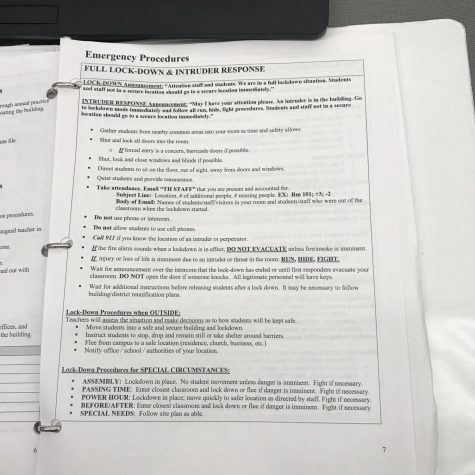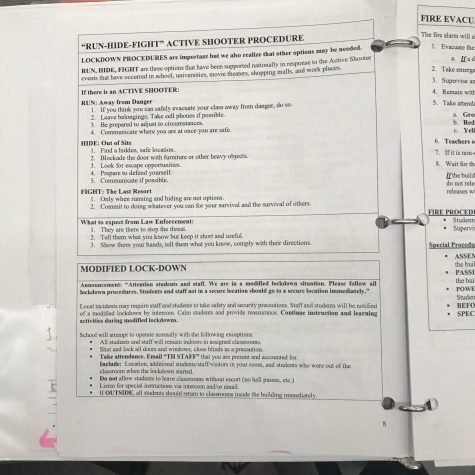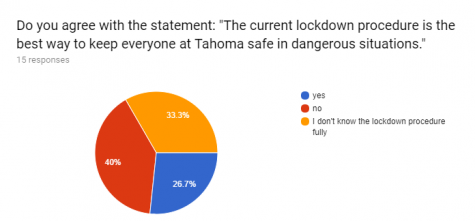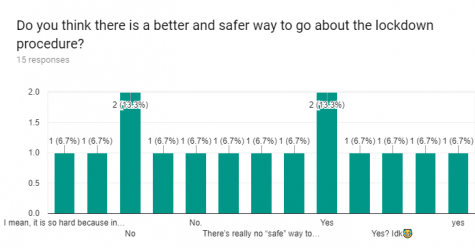Lockdown: Fact or Fallacy?
with mandatory drills, some questions remain about efficacy.
January 30, 2018
“May I have your attention please. An intruder is in the building. Go to lockdown mode immediately and follow all run, hide, fight procedures. Students and staff not in a secure location should go to a secure location immediately.” Teachers will then follow their programmed response to lock their doors and turn off the lights, sit and wait quietly, huddled in a dark corner, until authoritative help comes, in hopes the perpetrator will pass them by. The fallacy of this procedure is that it will be safe and effective in the event of an armed dangerous intruder with the intention to kill as many as they may find, which is tragically, not so uncommon. Students at Tahoma High School have mixed opinions on the topic.

A page from a safety handbook, titled “Full Lockdown and Intruder Response” that each teacher at Tahoma keeps in their classroom.
These attackers are usually mentally ill, many of them psychopathic, but they are not stupid or ignorant. They will exploit this lockdown policy model.
First of all, turning the lights off and hiding in a corner is not going to stop an intruder from knowing that people are in the building. Like Junior Mackenzie said, “ I feel like just hiding with the lights off is not a very effective way of protecting ourselves against an intruder. Like, girl, he or she knows we are in the building… lights off and no talking is not going to change that, ” sophomore Stephanie Melgoza concluded. “ I’m pretty sure if we had a shooter they would know that there’re people in here with a bunch of cars parked outside,” said Melgoza. Just hoping that the perpetrator will pass by each classroom and think that no one is in it, and hoping first responders will come in time for no casualties, is not enough.
Yet, others at Tahoma who are satisfied with the policy make some good points. Sophomore Oleg Fylck pointed out, “I believe that this procedure was thoroughly crafted and tested by the police in order to be the most effective in such an emergency. The police know best when it comes to such things since it is their job to do so. No other job field could create a more perfectly suited plan,” said Fylck.
Furthermore, classrooms seem as if it is the safest space to keep students in the situation of an intruder. Senior Ashley Walker stated, “ Everyone is in a safe space and has known whereabouts by staff. There are resources for protection in classrooms if needed and by being with others in a closed off space no one is alone in a dangerous situation.” Sophomore Madison Collins simply stated, “It seems like anyone outside their classroom when a lockdown occurs could be put in a lot of danger.” She’s right. It would be extremely dangerous to have students in the hallways or out in the open.
But this would be the situation for students not in a safe spot exactly when the lockdown occurs. Junior Lily Kindgren said, “It’s always drilled into our mind what to do if we’re in a classroom but what if we’re at lunch? Or went to grab something from our car? Or we’re coming in late or leaving school early?”
Sophomore Abby Wooster pointed out that this policy has a purpose, “Even though it may seem unnecessary to keep the doors locked when a student from the hallway is asking to come in, it is the safest option because an intruder may be next to them while holding a gun to their head threatening them to kill them if they can’t get their classmates to open the door for them. Then, if the classmates open the door, the intruder could endanger or possibly kill anyone in the classroom.” And that is a very real threat, but this rule of locking the doors and refusing to let anyone in could leave students stranded, out in the open.
Another problem that arises is the possibility of the perpetrator actually being a student at the school. These students already know the lockdown procedure, their way around the school, and where everyone will be. And the number of student school shooters has significantly risen in the past 10 years. Like Sophomore Sophie Goodgion said, “Anyone can come to the school with a gun. If a student does not seem suspicious of carrying a gun, they never get checked, so any student can come in the building with a firearm. Also, every student knows the procedure, therefore any student can “work around” it.”

Another page from a Tahoma Safety Handbook, found In Mr.Eggleston’s room, titled “Run-Hide-Fight” Active Shooter Procedure.
A poll taken from a variety of students at Tahoma High School shows that 40% of students polled believed that The current lockdown procedure was not the best way to keep everyone at Tahoma safe in dangerous situations while 26.7% believed that is was. Additionally, an alarming rate of students stated they did not even know the lockdown procedure fully.

Additionally, when asked if they think there is a better solution to the current lockdown procedure, ⅓ of students said yes, ⅓ said no, and the other ⅓ said “maybe.”

Some elaborated on their response. One said, “There’s really no “safe” way to any procedure. Someone is always crazy and bound to do something crazy, all you can hope is that you’re not in the wrong place at the wrong time.” Another said, “There should be a better way for students to escape an intruder while being in the hallways.” Another added “I mean, it is so hard because in a case of intruder it is so dangerous that there really isn’t much we can do to protect ourselves. Every man for themselves.”
One student said, “Probably, however, this is the best current lockdown procedure we have.” And this is the situation in place. What is the solution?
There have been some alternatives presented. Some experts say that teachers should have the right to carry guns. Others say code words and phrases should be used when calling for a lockdown. But will these solutions actually make schools safer or could they actually damage the procedure further?


